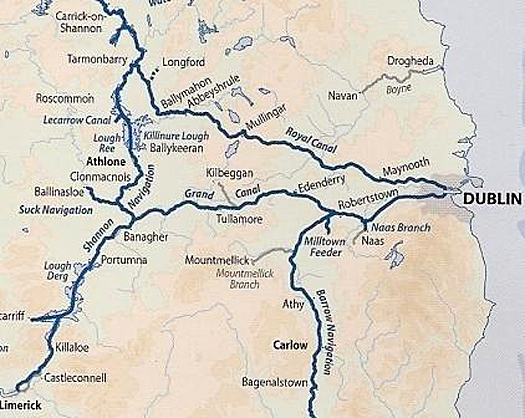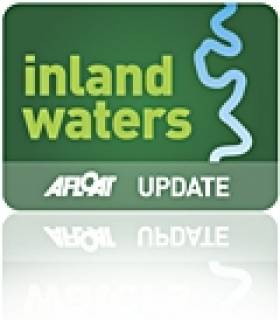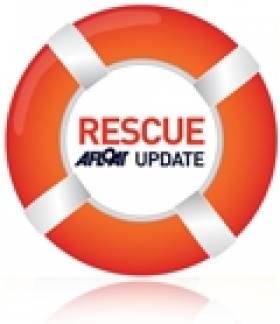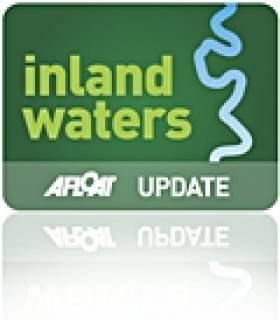Displaying items by tag: River Shannon
Three’s A Crowd as Naval, Research and Cargo Ships Dock In Galway
Also sharing the basin but located closer to the dock gates was Arklow Shipping Ltd's Dutch registered dry-cargo vessel Arklow Surf (2000/2,316grt). The dock is capable of handling more vessels simultaneously and of course used as a host-port of the high-profile Volvo Ocean Race which is due to return next year.
Galway and neighbouring Limerick City with its Ted Russell Dock, are the only dock-gate accessed ports on the island of Ireland. In the case of Galway there is an exception as freight operations are also available from an outer pier on the seaward side of Dún Aengus Dock though only for domestic purposes. From this pier the dedicated Aran Islands freight service is operated by Lasta Mara TEO's Blath na Mara (1983/330grt). As for Limerick, vessels can also berth outside the dock but they tend to be small port-work related craft that use the outer berth on the Shannon Estuary.
The Galway Harbour Company in recent years have proposed plans for a new outer port, to be built in four stages with a completion date set for 2017. This would enable larger deeper drafted vessels such as tankers and cruiseships to dock in the new port. In the meantime cruiseships anchor off Mutton Island. In addition a freight rail-link, berthing for an inshore fishing fleet and a 216 berth marina are proposed.
To read more about the port proposals visit http://www.galwayharbour.com/news.php?id=11and for aerial visual impressions click HERE.
- River Shannon
- Marine Institute
- naval service
- Ports and Shipping
- Arklow Shipping Ltd
- Ports and Shipping News
- Aran Islands
- Island News
- Galway Bay News
- Marine Science News
- Dun Aengus Dock
- Galway Harbour Company
- Cruise Liner news
- Cruise ships
- Galway Harbour and Bay news
- Ted Russell Dock
- Marine Instistute Research vessels
- Lasta Mara TEO
Shannon Port Facility Expected to Fetch €700,000
The Irish Times reports that Shannon Foynes Port Company is set to sell off extensive warehousing along with a development site facing the port.
Five separate warehouses extending to 5,297sqm are included in the sale, along with almost 1 hectare (2.44 acres) of development land.
DTZ Sherry FitzGerald is handling the sale by public tender on 28 September. The warehousing and site are likely to make more than €700,000 for the port company.
Shannon-side Marina an Investment Opportunity
A marina on the banks of the Shannon in Co Offaly on Ireland's inland waterways could be yours for €1.5 million.
Shamrock Marina, just downstream from Banagher, offers mooring space for around 100 boats during the summer months, but has the potential and space to expand well beyond this number.
There is also scope to develop residential and commercial premises on the property, making this an intriguing investment opportunity.
Waterside Properties has more details and photos HERE.
Sailors Plan Month Long Journey from Shannon to Liffey and Back
Nenagh resident and inland waterways enthusiast, Nick Theato, single-handed aboard 'Bo-Bo, a five metre Pedro trailer/sailer and Pat Kelly, Killadangan, with his son Andrew in 'Shu-Ra-Nu', a 6 metre Etap 20 trailer/sailer, plan to raise funds for Lifeboats Ireland by undertaking the IWAI Green & Silver Challenge in June, 2011. Their fundraising target is €5,000.00.
On the 25th June, 1946, Tom and Angela Rolt left Athlone aboard 'Le Coq', a 28ft.x8ft. converted ship's lifeboat on a voyage that would inspire contemporary and successive generations of inland waterways enthusiasts.
Tom Rolt wonderfully documented the voyage in his book 'Green & Silver', published in 1949, which has since become a classic. This work was instrumental in inspiring the small group who founded the Inland Waterways Association of Ireland in 1954, whose objective was to save the Shannon navigation from strangulation by low bridges. Indeed, the colour scheme of the IWAI's logo and burgee derive from the cover design of Rolt's book.
With the re-opening of the Royal Canal in October 2010, it is now possible to retrace Rolt's journey in full and complete the circular route formed by the Royal Canal, River Liffey, Grand Canal, River Shannon and Camlin River.
To celebrate this event, the IWAI has initiated the 'Green & Silver Challenge' in an effort to encourage people to make the circular journey. Nenagh resident, Nick Theato single-handed aboard 'Bo-Bo, a 16 foot Pedro trailer/sailer and Pat Kelly, Killadangan, with his son Andrew aboard 'Shu-Ra-Nu', a 20 foot Etap trailer/sailer, plan to raise funds for Lifeboats Ireland by travelling the full Green & Silver Route throughout June 2011.
Departing on June 1st, they will travel from Dromineer through Lough Derg and Lough Ree and enter the Royal Canal at Richmond Harbour. They plan to cross the Liffey in Dublin 17 days later, where they will take a welcome day off before commencing the return journey via the Grand Canal to Shannon Harbour. The journey will take approximately 28 days, will cover a minimum of 333 km. and navigate through 92 locks (some double), 91 of which are manual. Their fundraising target is €5,000

Nick Theato is Treasurer of the Lough Derg RNLI Fundraising Branch and Lough Derg Lifeboat Station at Dromineer.
Pat Kelly is Secretary of the Lough Derg RNLI Fundraising Branch.
Nick and Pat welcome all sponsorship, however modest. Contributions can be pledged online at http://www.mycharity.ie/event/green_silver_event/. Nick may be contacted on 086 1738014 ([email protected]). Pat is at 087 6908099 ([email protected]).
For further details / interviews / photos: Contact Pat Kelly at 087 6908099 ([email protected]). Support photography: Gerardine Wisdom 087 6522582 ([email protected]).
Kinsale Coast Guard in Daring Cliff Rescue
The Irish Coast Guard's Kinsale unit was involved in the dramatic rescue of a man clinging to the sheer side of a cliff on Sunday.
TheJournal.ie reports that the man, a 20-something English tourist, had been caught on the beach below at high tide and tried to climb the cliff face to escape, but got into difficulty half-way up.
The man was spotted by a couple walking the clifftop near Garrettstown Beach, who alerted the Old Head of Kinsale coastguard unit.
A cliff rescue expert abseiled down to attach a lifeline and harness, and the man was lifted to safety. He was treated at the scene for cuts and bruises.
Unit officer in charge Eddie Butler told the Irish Examiner that the man didn’t know how he had held on as long he did.
"When we arrived and saw the situation, I didn’t think we’d save him. I think we got to him just in time," said Butler. "The water was raging beneath him. If he had lost his grip and fell in, he would have been lost."
Elsewhere, six people were rescued from a sinking cruiser in the River Shannon on Sunday afternoon following its collision with a bridge in Killaloe, Co Clare.
According to The Irish Times, two members of the Irish Coast Guard's Killaloe unit arrived quickly on scene two help the six occupants and their dog to safety on the riverside.
The Killaloe unit reports that the cruiser was subsequently run aground in the shallows at Ballyvalley to prevent its sinking.
Daring Night Raid on 60 Shannon Boats
Gardaí in Carrick-on-Shannon are investigating a serious raid at a marina that saw as many as 60 boats vandalised.
The Irish Times reports that the raid early on Tuesday morning involved a five-strong masked gang using a number of vehicles, who robbed at least 40 of the boats of nautical instruments and electrical equipment and damaged 20 others.
The vessels appear to have been targeted among the 300 boats moored at Butler's marina on the River Shannon. The cost of damage to the boats is not yet known.
A staff member at Butler’s marina told The Irish Times that the company was not in a position to comment on the case.
Meanwhile, there are plans to circulate a list of all stolen items among Ireland's inland boating community.
Shannon Sinkings Result of Poor Winter Preparation
Owners of boats moored on the River Shannon and its tributaries and the inland waterways are counting the costs of the recent icy conditions which have caused the sinking of a high number of vessels.
The Irish Times reports that the Inland Waterways Association of Ireland (IWAI) has advised all boatowners to check their boats after reports of sinkings across six counties.
Among the sunken vessels are a 35ft cruiser opposite the Landmark Hotel in Carrick-on-Shannon. The worst situation is reportedly in Shannon Harbour, with an unusually high number of boats sunk or partially submerged.
Sunken boats often require full refitting to replace damaged finishings and damaged electronics. But of greater concern is the potential environmental impact due to fuel or oil spills, or the leaking of antifreeze and other chemicals.
The IWAI has blamed poor 'winterisation' as a factor in the sharp increase in sinkings.
Winterisation involves the closing of sea cocks to prevent water entering the intake pipes and potentially bursting them when it freezes, or leaking when it thaws.
"Owners need to check on their craft regularly or have a local do it," said IWAI president Paul Garland. "The lessons learned this winter must be taken seriously. Heaters may not be enough; all sea cocks have to be shut."
Click HERE for Afloat.ie's advice on protecting your boat in the thaw.
Take Care Navigating Abbey River When Turbines Operate
Waterways Ireland has issued a reminder to users of the inland waterways on the Shannon Navigation that it is advised not to undertake a voyage if more than one turbine is operating, due to increased velocity of flow in the navigation which can be dangerous. The situation may also arise when flood conditions prevail.
Contact the lock keeper at Ardnacrusha (tel: 087-7972998) for information on the number of turbines in operation at Ardnacrusha before commencing transit of this part of the river.



































































